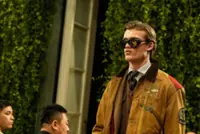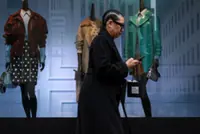A file picture shows Jisoo arriving for the presentation of creations by Dior at Paris Fashion Week. Photo: AFP
This season, when throngs of fans screamed from the crash barriers outside a Paris fashion show or jostling photographers and gawkers wielding cellphones triggered a commotion at a front row, the centre of attention was rarely a Hollywood actress or British rock star.
Instead, the most frenzied scenes – and online clicks – were ignited by Asian celebrities, whose dominance on the fashion week celebrity circuit hit new heights.
At Dior, Natalie Portman and Jennifer Lawrence, both ambassadors for the brand, watched as crowds went berserk for pop idols Jisoo from Blackpink and Mingyu of Seventeen, both of South Korea; Filipino actor and model Pia Wurtzbach; and Chinese singer Xin Liu, whose fan army, clad in ice blue and clutching signs, later followed her all over the city.
Chinese actress Yang Mi snagged a prime position between Michael Burke, CEO of the LVMH fashion group, and Pascale Lepoivre, CEO of Loewe.
At Saint Laurent and Louis Vuitton, the biggest screams greeted Rose and Lisa of Blackpink; at Acne Studios, fans went wild for a shirtless Johnny Suh, the Korean American singer, flanked by J-pop star Mandy Sekiguchi and members of ILLIT, the latest band to emerge from Hybe, an agency that represents K-pop acts, including BTS.
Read more: As these celebrities are showing, comfort remains a key footwear trend
Similar scenes took place in Milan and at the Burberry show in London, where official brand ambassadors, including Chinese actress Tang Wei, Thai actor Vachirawit Chivaaree, known as Bright, and South Korean soccer star Son Heung-min, were all in attendance.
Fashion brands have cultivated relationships with key Chinese and South Korean ambassadors for more than a decade. But in a volatile luxury landscape with a stagnating North American market, Southeast Asia has become increasingly important.
Data from consulting firm Bain & Co. predicts regional sales growth of 4.8% in 2024, with Thailand expected to grow the most thanks to its local consumer base and tourism from neighboring Asian countries.
Now many fashion houses are doubling down on celebrity partnerships from that region, especially with stars from Thailand, Indonesia and the Philippines.
In a world obsessed with celebrities, the right endorsement by the right face at the right time is the most powerful marketing move a brand can make.
Competition among brands to sign contracts with famous names is increasingly fierce and expensive.
“We look for the best in class in their field, be it acting, singing or sport, and also people we know can really personify the look and aesthetic of Burberry,” said Rod Manley, chief marketing officer of Burberry, about its criteria for a brand partner, adding that Asia accounts for more than a third of Burberry sales.
After a celebrity’s fashion week appearance or a social media post by a star wearing branded product, fashion companies scrutinise online impressions and engagement, as well as photographs and content across social and traditional media platforms and geographical markets to quantify the value of their investment.
“When it comes to Asian celebrities and platforms, some of these numbers are astronomically high and reach more than Western ambassadors,” Manley said.
“Especially when they have a new project like a TV series coming out, which doubles the impact of having them associated with the brand.”
Launchmetrics, a data analytics and software firm, uses an algorithm it calls Media Impact Value to assign monetary value to posts, placements and articles.
Last season it found that a single appearance by Jisoo of Blackpink at a Dior show accounted for 14% of total media impact value – or US$8.1mil (approximately RM37.9mil) – for the fashion house.
In comparison, Western names such as Robert Pattinson accounted for US$2.7mil (RM12.6mil) and Lawrence, US$4.5mil (RM21.1mil).
Dior declined to comment for this article.
According to Alison Bringe, chief marketing officer of Launchmetrics, contracts with Asia Pacific celebrities bring partner brands both local and global credibility, especially at a time when many shoppers are embracing representation and cultural inspiration outside their home country.
At fashion shows in Europe today, she said, fans screaming at the doors for a glimpse of South Korean or Thai stars are just as often from Italy or France as they are from Asia or of Asian heritage.
While some American stars continue to significantly influence fashion trends, notably Zendaya and Kylie Jenner, there is a willingness among Asian celebrities to experiment with their wardrobes that makes them appealing for Western brands, Bringe said.
And social media plays an outsize role in influencing consumer behaviour in Asia; online, fans often tell one another to buy products recommended by their idols.
At the Acne Studios show last week, Suh, who found fame with boy band NCT, made his Paris Fashion Week debut posing on a giant chair made out of tires. He wore denim flares and a long biker jacket over a bare chest, his flowing black hair dyed orange at the tips.
Read more: Blackpink's Jisoo, Uma Thurman: Celebrity spotting at the womenswear shows
It was nearly impossible to enter the show because of his screaming followers.
“Johnny is a very good fit for us,” a spokesperson for the brand said, noting that Suh “embodies the androgynous spirit of Acne Studios and has a very creative personal sense of style".
Manley of Burberry added that unlike their Western counterparts, celebrities from South Korea, Thailand and other Asian countries are usually more amenable to interacting with their fans and view it as part of their job, spending significant time taking selfies and signing autographs before or after an event.
Asian celebrities also draw big crowds in the region, he added.
“You sort of expect a scene at fashion week,” he said, “But when we do a store opening in Asia and invite stars, thousands of fans will descend on that shopping mall compared to say 100 elsewhere. It’s just not on the same scale.” – The New York Times





